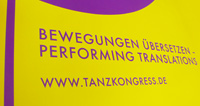
The term translation is usually first associated with the medium of language. But how do transfer processes in a broader sense unfold? How do we “translate” between practices, value judgements and behaviour patterns from different cultural contexts? And what role do bodies and movements play in them? In the light of a present that is shaped by processes of globalisation, cultural (and thus also artistic) identities can be grasped neither through demarcations nor by means of levelling concepts such as homogeneity and continuity. Instead, dynamic concepts of interweaving, hybridity and transformation are used to describe transnational and intercultural phenomena. The focus is therefore placed on methods of translation, transfer and mediation within and between different cultures.
Under the motto ‘Bewegungen übersetzen – Performing Translations’, the Dance Congress 2013 presents positions and initiatives as well as academic research approaches that are concerned with the exchange between different body concepts, movement repertories and modes of practice. Among the themes being addressed are, for example, the – from a European perspective – surprising combination of contemporary dance, yoga, and urban activism in a metropolis like New Delhi or the dance practices of indigenous people in the South Pacific, which are directly linked to their liberation movements. Alongside such contributions on the interrelations between artistic and social movements, the Congress presents critical examinations of normative body images, for instance, differently abled or aging bodies, which are underrepresented in Western contemporary stage dance and whose perception and appreciation is always also culturally influenced. Furthermore, the tensions between global art production on the one hand and national or regional cultural policies on the other will be examined based on exemplary productions, festivals and networks. What representations of “Indian dance” or “African dance” dominate the European market and how do they influence the conditions of artistic production?
The events are organised along the lines of seven overarching thematic fields that go beyond the participants’ customary areas of interest and work inviting them to a confrontation of heterogeneous positions and actors. As diverse as the thematic focuses are, what they have in common is the claim of initiating translation processes.
With its profile, the Dance Congress is a congress for dance, yet one that treats the concept of dance in an extremely broad sense and thus proves the art form’s relevance to other disciplines and the connectivity of its discourses beyond dance.